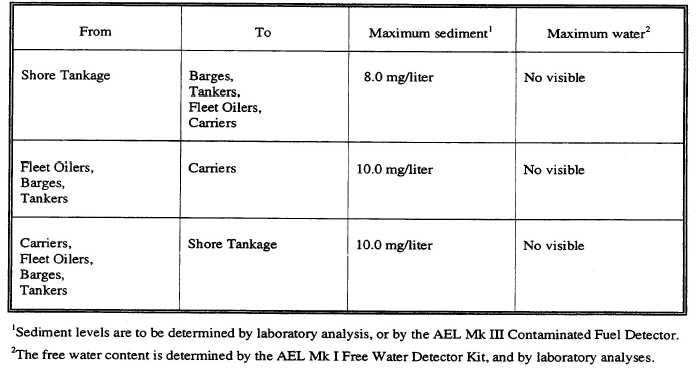All ships fitted with two or more downcomers
can use any or all to expedite the refueling operation.
The number of tanks that can be opened and the
method of receiving will vary on the individual ships,
depending on the number of personnel available as
manifold operators, sounding teams, etc., and the
experience gained after several refueling operations.
NOTE
An adequate number of contamination tanks
must remain empty to receive the recirculated
fuel from Cla-Val stations.
When the last port and starboard tanks to be
filled reach 80 percent capacity, notify the tanker to
reduce pumping. Top off the last tanks. When the
overflow tanks reach 95 percent capacity, order the
tanker to stop pumping.
After the tanker has ceased pumping, close the
filling connection gate valve on the sponson.
At the completion of the replenishing operation,
notify the officer of the deck of the start and stop
pumping time and record the total gallons received.
This information is entered in the ship’s log.
Secure and restow all equipment. Close all
valves in the filling and transfer system. The tanks
should be sounded to obtain an accurate account of all
JP-5 on board. During the final soundings, compare
readings with the tank level indicators and adjust as
necessary.
CRITERIA
FOR
ACCEPTANCE
OR
REJECTION OF JP-5.—The standards of fuel
cleanness (table 4-4) are established as maximum
limits for transfer of aviation fuels between shore
activities and ships. Normally, contamination levels
are maintained substantially below these levels.
Samples are taken continuously from the filling
connection at the initial start of pumping until a clear
sample is obtained. Thereafter, samples are taken
every 15 minutes during the refueling operation. Any
time a sample exceeds the contamination limits listed
in table 4-4, the pumping operation must cease. The
final decision of acceptance or rejection of the fuel
rests on the commanding officer.
EMERGENCY BREAKAWAY.—During a
refueling at-sea operation, any number of unforeseen
circumstances could occur, making an emergency
Table 4-4.—Standards of Fuel Cleanness
4-66

